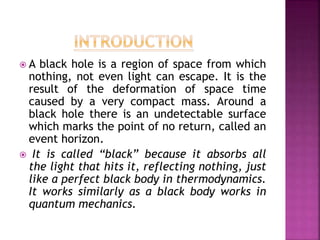Blackhole
- 1. Engineering Physics â 2110015 âTopic: Black Holeâ Guided By: Prof. Sanket Thakor Branch : Mechanical Engineering Div: L-3
- 2. Group of the Students Students name and Enrollment No. Harshil Zaveri (130120119251)
- 3. ï A black hole is a region of space from which nothing, not even light can escape. It is the result of the deformation of space time caused by a very compact mass. Around a black hole there is an undetectable surface which marks the point of no return, called an event horizon. ï It is called âblackâ because it absorbs all the light that hits it, reflecting nothing, just like a perfect black body in thermodynamics. It works similarly as a black body works in quantum mechanics.
- 5. ï There are many theories to that question. ï Most common theory is where a colossal star with a mass of more than 3 times the Sunâs reaches the end of its life, gets crushed under its own gravity, leaving behind a compact black hole. ï When a gignatic star reaches the final stage of its life and is about to go supernova, it spends all the nuclear fuel by then. So it stops burning and heating up and cannot create the nuclear energy required to feed the star.
- 7. ï The black hole is surrounded by an event horizon which is the sphere from which light cannot escape ï The distance between the black hole and its event horizon is the Schwarzschild radius (RSch= 2GM/c2) ï The center of the black hole is a point of infinite density and zero volume, called a singularity
- 8. How Black hole look alike? 8
- 9. 9 1915: Einsteinâs Theory of Gravity predicted the possibility of black holes, but no one believed they actually existed! 1967: Term âBlack Holeâ coined 1970âs: Convincing evidence that black holes are real Today: NASA space telescopes have discovered evidence for black holes throughout the universe Albert Einstein
- 10. 10 What did Einstein say about Gravity? Mass distorts space - âcurvingâ it Objects and light moving near the massive object are forced to take a curved path around the object. Just like the Moon orbiting Earth. Images courtesy of Professor Gabor Kunstatter, University of Winnipeg
- 11. 11 How much would you âweighâ? On Earth, letâs say you weigh 150 lbs. On the Moon, youâd weigh 25 lbs. On Jupiter, youâd weigh 350 lbs. On the Sun, youâd weigh 4,000 lbs. Near a Black Hole, youâd weigh over 20 TRILLON POUNDS !!!
- 12. 12 Where do black holes come from? Three classifications of black holes: ï§ Stellar-mass: 3 to 20 times the mass of our Sun ï§Supermassive: Black holes with millions to billions of times the mass of our Sun ï§Mid-mass: In between stellar-mass and supermassive
- 13. 13 Stellar-mass: Black holes are made when a giant star, many times the mass of our Sun, dies. Most of the starâs atmosphere is blown into space as a supernova explosion. The starâs spent core collapses under its own weight. If the remaining mass is more than the mass of 3 Suns, it will collapse into a black hole. Where do black holes come from? Credit: European Southern Observatory
- 14. 14 Supermassive: Extremely massive black holes have been found in the centers of many galaxies - including our own! Where do black holes come from? Credit: European Southern Observatory (ESO) - Very Large Telescope
- 15. 15 Mid-Mass: Scientists are finding these in the centers of large, dense star clusters. Like this globular star cluster, called M15, in our Galaxy. Where do black holes come from? Image Credit: NASA and The Hubble Heritage Team (STScI/AURA)
- 16. 16 Falling into a Black Hole Not to Scale
- 17. 17 Falling into a Black Hole Not to Scale
- 18. 18 Falling into a Black Hole Not to Scale
- 19. 19 Falling into a Black Hole Not to Scale
- 20. 20 M74 Photo Credit: NOAO/AURA/NSF Great distances between the So how do we survive amid all these Black Holes?
- 21. 21 M74 Photo Credit: NOAO/AURA/NSF Sunâs orbit > Everything is orbiting fast So how do we survive amid all these Black Holes?
- 22. 22 Including one giant black hole at the very cen There are 200 billion stars in our galaxy, the Milky Way There are also millions of black holes How have we survived?
- 23. 23 What would happen if the Sun wasâĶ Not to Scale
- 24. 24 âĶ changed into a Black Hole? Not to Scale
- 25. 25 How do we know itâs there? Hot material falling into the black hole. âWeirdâ motions of objects nearby Jets of glowing gas Credit: ESA, NASA, and Felix Mirabel
- 26. 26 How do we know itâs there? Movie courtesy of R. Spencer, S. Garrington, D. McKay, T. Muxlow, P. Thomasson, C. de la Force, A. M. Stirling (University of Manchester, Jodrell Bank); G. Pooley (University of Cambridge); R. Fender (University of Amsterdam) Jets of glowing gas One month
- 27. 27 10 mind-blowing facts about Black hole
- 28. 28 Thank YOU



























